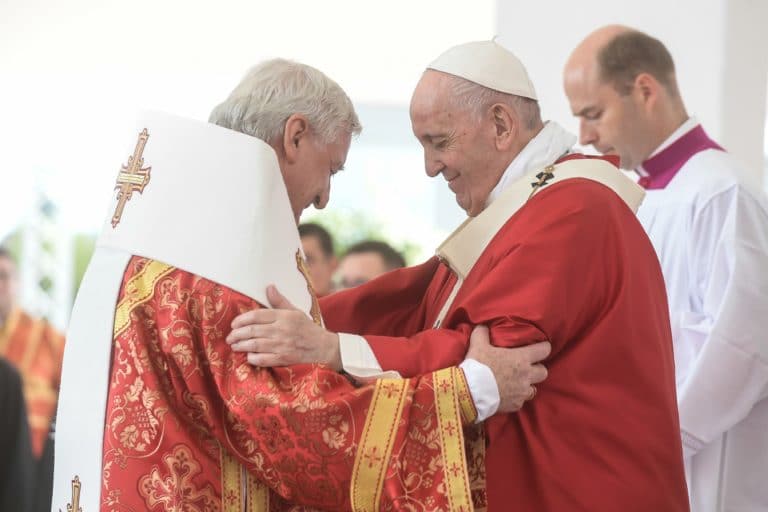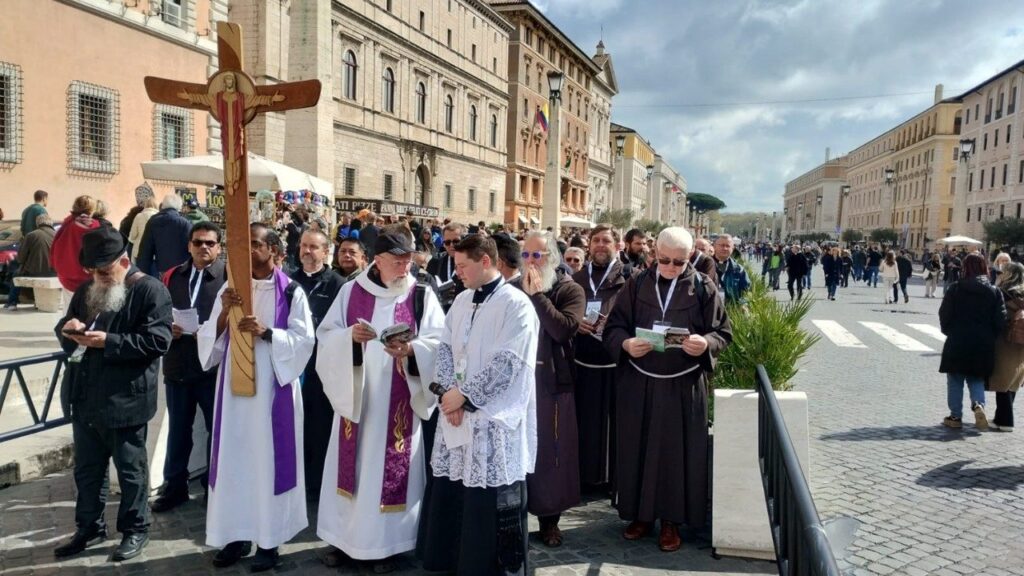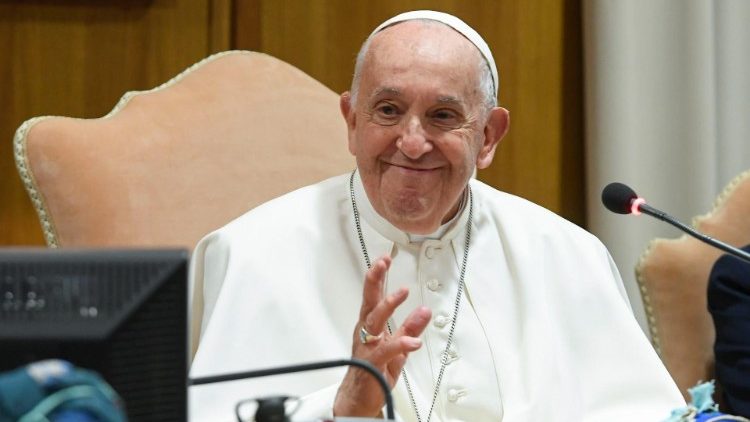Christ’s ‘Cross Is the World’s Best Pulpit’
Greeting to Pope During Saint John Chrysostom’s Divine Liturgy by Archbishop of Prešov

“Cross is the world’s best pulpit,” said today Monsignor Ján Banjak, Metropolitan Archbishop of Košice.
On the third day of his 34th Apostolic Journey, Pope Francis presided over Saint John Chrysostom’s Divine Liturgy in Prešov’s Mestska Športova Hala Square. Welcomed by Monsignor Ján Banjak, the Holy Father blessed the bread and salt offered by two children. After his homily, the Archbishop greeted him.
Around 7:40 am today, September 14, 2021, the Holy Father left Bratislava’s Apostolic Nunciature and went to the capital’s International Airport to board a plane that took him to Košice. On arrival, he was welcomed by Monsignor Bober and Monsignor Cyril Vasil’, the city’s Eparch for Catholics of the Byzantine Rite, as well as by the Mayor and other Authorities. The Pontiff went immediately to Prešov’s Mestská Športová Hala Square.
The celebration of Saint John Chrysostom’s Divine Liturgy took place on the Solemn Feast of the Exaltation of the Cross; it was divided into several parts: the Liturgy of Preparation, the Liturgy of the Catechumens, the Liturgy of the Word, the Liturgy of the Faithful, the Eucharistic Liturgy, which was done in Italian, and the Closing Rites. Following these ceremonies, Archbishop Babjak delivered his greeting address to the Pope.
Love for the Bishop of Rome
After expressing his joy for the Bishop of Rome’s visit, Monsignor Babjak said he reflected on the words of the Successor of Peter in the homily and expressed his intention to inculcate them in his heart, “so that it awakens in us greater love and happiness for Jesus Christ, for the Most Holy Virgin Mother of God, for Jesus’ Cross, and for you, dear Holy Father.” The Metropolitan Archbishop also said that the Greek-Latin Church of Slovakia has always loved Pope Francis. “We pray for you and for the apostolic work you do worldwide, strengthening your brothers in the Faith. We know with what love you are concerned for the marginalized, how much you love them precisely because they suffer, configured to Jesus Christ who redeemed us by His Death on the Cross and Glorious Resurrection.”
Then Monsignor Babjak stressed that “the Cross is the Chair of God,” and to support this argument he quoted the Holy Father’s words during a General Audience last year: “It will do us good to look at the Crucifix in silence and see who Our Lord is: He is the one who doesn’t point the finger at anyone, not even at those that crucify Him but opens His arms to all.”
Mestská Sportova Hala
Prešov’s Sports Palace is located on John Paul II street; built in 1978 and renewed between 2002 and 2004, it has a capacity of 3,800 seats. It’s the most important sports center of the city. Sports practiced there include volleyball, handball, soccer, lawn hockey, and disciplines such as wrestling, gymnastics, and aerobics.
It is also the venue for mass events and, in the time of pandemic, a center of vaccination against COVID-19. There is a commemorative plaque in one of the building’s outside pillars: on the Second Sunday of July 1995, a meeting of Catholics of Byzantine Rite was held there. The Divine Liturgy presided over by Pope Francis, took place in front of the main building, with a capacity for 53,000 faithful.
Prešov
A city with 90,000 inhabitants, at present, it is located in the Valley of the Torysa River, in Eastern Slovakia, and 33 kilometers North of Košice. It’s the country’s third-largest city and capital of the Šariš region. Colonization of this region began in the Stone Age, documented by important archaeological finds in the Valley of the Delna River.
The find of gold and silver Roman coins attests to the economic relations between Prešov and the Roman Empire. At the end of the 8th century came under the control of the Kingdom of Hungary; Hungarian soldiers established themselves in the city.
Prešov is first mentioned in a document written by King Bela IV in 1247. In 1299, thanks to King Andrew III, the town acquired the status of a city and in 1374 it was granted the title of Free Royal City. In the 14th and 15th centuries, the capital enjoyed economic prosperity and received its Coat of Arms from King Ladislao V in 1453.
The city’s prosperity and development on a great scale during this period were manifested in a marked increase of the population, from 2,000 in 1425 to 3,300 in 1491. The reforms and anti-Habsburg rebellions in the 16th and 17th centuries, as well as natural disasters and the plague, triggered the city’s decline.
The so-called “Massacre of Carafa, carried out by Italian General Antonio Carafa, at the service of the Holy Roman Empire, marked the year 1687. Twenty-four Protestant citizens, accused of having supported Omre Thököly, leader of the anti-Habsburg rebellion, were executed in the historic capital.
When Saint John Paul II visited the city of Prešov in 1995, he prayed at the monument for the victims of that massacre. Thanks to immigrants, the city took up its development at the end of the 18th century and beginning of the 19th, which also contributed to the production of salt, which is unique in the country. In 1816, the Greek-Catholic diocese was founded, and the first Ruthenians and Jews began to arrive. The city’s monuments are concentrated in its historical center, which extends around Hlavná Ulica street.
Its main landmarks are Saint Nicholas’ Gothic Cathedral with its high tower, built in the mid 14th century; the Rákózci Renaissance Palace, which today houses the Regional Museum; the City Council, one of the city’s oldest monuments, Neptune’s Fountain; the 18th-century Greek-Catholic Cathedral of Saint John the Baptist, which houses a copy of Turin’s Holy Shroud; and the Baroque Calvary complex, founded at the beginning of the 18th century by the Jesuits and located on a hill West of the City.
Arch-Eparchy of Prešov
Prešov’s Arch-Eparchy for Catholics of the Byzantine Rite — created an Eparchy on September 22, 1818, and metropolis on January 30, 2008 –, has 117,800 Catholics, 163 parishes, 18 churches, 282 diocesan priests (eight Ordained this last year), 19 regular Priests residents in the diocese, two Permanent Deacons, 42 seminarians studying Philosophy and Theology, 22 members of masculine Religious Institutes, 73 members of feminine Religious Institutes, nine educational institutes, four charity institutes, and 1,572 Baptism in the last year.
Prešov’s Metropolitan Arch-Eparch is Monsignor Ján Babjak, who was born in Hažin nad Cirochou, in the same city, on October 28, 1953. He was ordained a priest on June 11, 1978, and elected on December 11, 2002. He was consecrated on January 6, 2003, and promoted to the office of Bishop of Prešov.
Košice
With 238,138 inhabitants, it’s the country’s second city, capital of the province of the same name in the East of Slovakia. It is located at the foot of the eastern slopes of the Metalliferous Mountains, 20 kilometers from the Hungarian border. It’s a University city, was the European Capital of Culture in 2013, and seat of important political and academic institutions.
Its strategic location at the crossroads of the old trade routes, it has always contributed to the development of its center, which grew near the confluence of the Hornad and Torsda Rivers. In the Middle Ages, it was the Head of the Pentapolitan League, which united five major trade centers of Eastern Europe (Košice, Bardejov, Levoča, Prešov, and Sabinov). The Valley where it’s located has been inhabited since the Paleolithic Age but was founded in the 13th century by the Slav communities of Krasna and Hornadom.
They built a Benedictine Abbey here, center for the spread of culture, which was consecrated in 1143. Košice is mentioned for the first time in an old Lubin document of 1230 with the name “Villa Cassa.” In 1249, King Bela IV of Hungary granted it the title of city and in 1342 it received the status of Free Royal City.
On May 7, 1369, it was the first European city to receive a municipal shield from King Louis the Great, a date that today is celebrated as “Košice’s Day.” In the first half of the 14th century, it enjoyed a great period of prosperity and was considered one of the main cities of European trade and of Central Europe.
In the 16th and 17th centuries, marked by the rebellions against the Habsburgs, the wars against the Turks, and the religious wars between Catholics and Protestants, the city experienced a serious decline. Three priests were martyred there — Croatian Marcos of Krizevci, Canon of Esztergom’s Cathedral, and Jesuits Melchiorre Grodziecki of Silesia, Poland, and Hungarian Pongracz, murdered on September 7, 1619, by Calvinist soldiers for his loyalty to the Church. Beatified in 1905, the three martyrs were canonized by Saint John Paul II in Košice in 1995.
Near the site of their martyrdom, Bishop Benedict Kishdy of Eger founded Košice’s first University, today the Pavol Jozef Šafárik University, which he entrusted to the Jesuits. The city grew in the 18th and 19th centuries when it became one of the most important industrial cities of Hungary.
In 1918 it became part of the first Czechoslovakia, and although the Hungarian war occupation from 1938 to 1945 caused an economic and demographic crisis, at the end of World War II the city became for a time the capital of a re-established Czechoslovakia. It experienced marked growth in the 50s, accelerated especially by the construction of the steelworks in Eastern Slovakia.
In the space of a generation, there was an even greater expansion of its built surface. Almost all the city’s monuments are concentrated in the historical core. One can admire in the main street, Hlavná Ulica the 14th-century monumental Gothic Cathedral of Saint Elizabeth, the country’s largest church, and Saint Urban’s Tower, Saint Michael’s Gothic Cathedral, ancient ossuary of the end of the 14th century, consecrated to Saint Michael, Patron of the dead.
Archdiocese of Košice
Created on August 10, 1804, and Metropolis on March 31, 1995, it boasts an extension of 10,430 square kilometers, which has 1,156,600 inhabitants, of whom 678,400 are Catholics. There are 221 parishes, seven churches, 404 diocesan priests (four Ordained this last year, 87 regular priests residents in the diocese, three Permanent Deacons, 33 seminarians studying Philosophy and Theology, 103 members of masculine Religious Institutes, 288 members of feminine Religious Institutes, 44 educational centers, 35 charity Institutions, and 7,786 Baptisms in the last year.
The Archbishop is Monsignor Bernard Bober, born in Zbudské Dlhé, Archdiocese of Košice, on November 3, 1950. He was ordained a priest on June 8, 1974, elected Titular of the Church of Vissalsa on December 28, 1992, consecrated on January 30, 1993, promoted on June 4, 2010, and ascended on June 4, 2010.
Eparchy of Košice
The Eparchy for Catholics of the Byzantine Rite is (since January 30, 2008), suffragan of Prešov. It has 73,487 Catholics, 95 parishes, one church, 161 regular priests residents in the diocese, one Permanent Deacon, 26 seminarians studying Philosophy and Theology, 14 members of masculine Religious Institutes, 35 members of feminine Religious Institutes, 12 Religious Institutes, 12 Educational Institutes, four Charity Institutes and 1,040 Baptisms in the last year.
Monsignor Cyril Vasil’ is the Eparch. He was born there on April 10, 1965, and Ordained priest on June 14, 1987, elected Titular of the Church of Tolemaida Libia on June 7, 1987, appointed Apostolic Administrator sede plena of the Eparchy of Košice for Catholics of the Byzantine Rite on January 20, 2020, appointed Eparch of the same See, keeping the personal title of Archbishop, on June 24, 2021.
Translation by Virginia M. Forrester
Related

Technology with a Human Face: Pope Francis’ Call for Ethical and Caring Use
Exaudi Staff
01 April, 2025
1 min

Pope Francis Continues Optimistic Recovery and Maintains Work Pace
Exaudi Staff
01 April, 2025
2 min

The Pope to the Missionaries of Mercy: God became man to reveal to the world that he never abandons us!
Exaudi Staff
30 March, 2025
2 min

God’s Mercy and the Call to Peace in Pope Francis’ Angelus
Exaudi Staff
30 March, 2025
3 min
 (EN)
(EN)
 (ES)
(ES)
 (IT)
(IT)

